How many reasons are there why many vending machines exist in Japan?
September 18, 2018
Many people know that there are many vending machines in Japan.
There are also vending machines that sell not only drinks and tobacco but also ice, cup noodles, candy, bananas, pizza, books, umbrellas, diapers, crepes and so on.
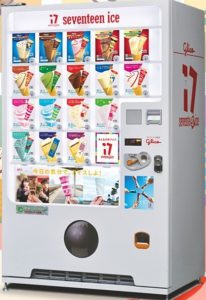
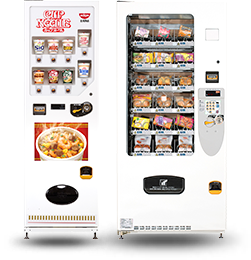
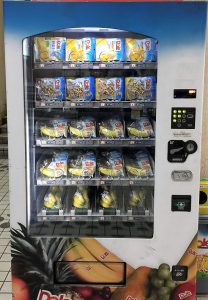
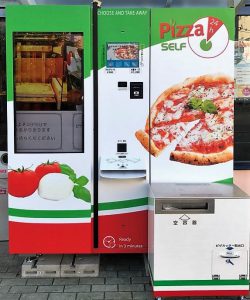
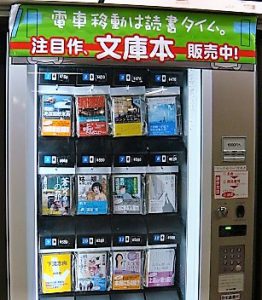
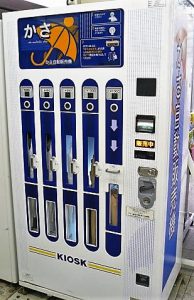
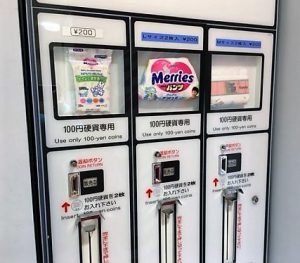

* Aside from that, in the event of a disaster such as an earthquake, there are many vending machines with offering the products (mainly drinks) contained free of charge.
Vending machines that brew drip coffee are also popular.
https://www.youtube.com/watch?v=TFSi2b1LPMQ
The most surprisingly, there is a vending machine that sells wedding rings. It seems there are people who propose while going out and buy them immediately after that.
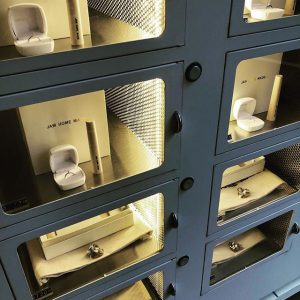
By the way, how many reasons are why many vending machines exist in Japan? (please read the following after considering the reason, )
https://www.youtube.com/watch?v=9UJzVLXmBG4
In this movie, in addition to the safeness in Japan, other reasons are mention, for example “high population density”, “personnel expenses of salespeople is high”, “cash society (often using coins)” “Japanese like robots and machines”
Besides these, there are the following reasons.
“Summer is hot” By the way, sales of vending machines are peak in summer, and in winter there is only half of sales in summer.
“Landscape rules are not strict”
“The beverage maker lends a vending machine to the land owner for free.” The owner of the land gets a commission according to the sales amount from the beverage maker, so you can start a no-risk business on a narrow land.
Do you have the same reasons?
In this way, thinking as “what’s the reason?”, is helpful for business as well, and comparing it with other countries will help you to rediscover the uniqueness of Japan.
Either way, the primary reason for existing so many vending machines in Japan is that Japanese public security is extremely good. I hope that Japan will be safe from now on.
Three points when telling the message to Japanese people / British who uncover “inconvenient truth” in Japan
August 17, 2018
Do you know David Atkinson?
The other day, I had the opportunity to hear his lecture, and I also read his books, I got a new awareness. Therefore, this time, I will introduce him.

(1) Who is David Atkinson?
His bio is as follows. (Some excerpt from Wikipedia)
———————————
He learned Japanese studies at Oxford University. He worked for Andersen Consulting (the predecessor of Accenture) and Solomon Brothers and came to Japan around 1990. In 1992 he moved to Goldman Sachs and worked as an analyst, pointed out a huge amount of bad debts sleeping at Japanese banks after the collapse of the bubble economy. After being promoted to a partner in 2006, he left the company in 2007.
After retiring from analysts and devoting to Japanese tea ceremony, he joined Konishi Arts & Crafts Co., Ltd., which is repairing Japanese national treasures and important cultural properties, in 2009. In 2010 he became chairman of the company. After that, as an expert of Japanese cultural assets, he also makes suggestions on Japanese cultural property policies and tourism policies. From June 2017, assumed the special adviser of Japan National Tourism Organization.
———————————
(2) What is the inconvenient truth of Japan that Mr. David Atkinson exposes?
In his book “新・所得倍増論”(new edition – income doubling theory), he pointed out the low productivity of Japan.
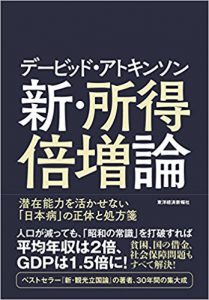
For example, we, Japanese people have been heard the brilliant achievements of the Japanese economy as follows.
———————————
GDP = 3rd in the world
Export value = 4th in the world
Number of Nobel laureates = 7th in the world
———————————
However, he insists that “Because these are all influenced by the high population of Japan, we should see per capita figures, not absolute numbers.” Therefore, when looking at the above three items “per capita”, it turns out
———————————
GDP = 27th in the world
Export value = 44th in the world
Nobel laureate winners = 39th in the world
———————————
and it is never a special country.
For reference, the export value is only 48% of Germany (3rd in the world). Moreover, since the population of Japan is 1.6 times more than Germany, the per capita export value of Japan is only 1/3 of that of Germany.
He mentioned the incompetence of Japanese executives as follows, touching on Japan’s population decline problem.
“Japan was booming in the 1970s not because Japanese executives were excellent because they benefited from population bonus due to the rapid increase in population. When the population declined in the 1990s, it was necessary to completely change the way of economy, but Japanese executives did not recognize it. In Japanese-style management so far, emphasis was placed on “management” of things. It is fine for the time of constant growth, but now is different. Despite the fact that there are the most competent workers in the world, Japanese executives who showed only the lowest productivity in developed countries can be said to be ‘crisis’. ”
(3) Three points when telling the message to Japanese people
I was able to take the above-mentioned “inconvenient truth” obediently. I think that there are the following reasons.
- He uses objective data.
- He is familiar not only with the Japanese economy but also with Japanese culture.
- We can feel his passion of “I want to improve Japan”
And I think, these three points are also important when non-Japanese people persuades or advises the Japanese. For example, when you suggest something to your Japanese boss or Japanese management or Japanese clients, if you clear these three points, the success rate will be high.
デービッド・アトキンソン 新・所得倍増論
(ISBN-13: 978-4492396353)

デービッド・アトキンソン 新・観光立国論
(ISBN-13: 978-4492502754)
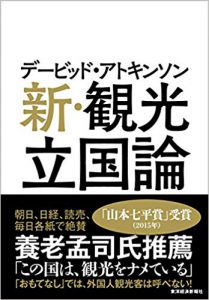
For those who are involved in inbound business, this book is also recommended.
It is recommended to read Japanese business magazines for business Japanese learning. Newspapers are also good, but since there are many new topics, the information can be sporadic, so the magazine is better to intensively read topics of interest in feature articles etc. Besides, information is useful for business, so it is two birds with one stone.
So, I tried searching for business magazines at Fujisan, a Japanese No1 online bookshop for magazine’s, but I hit 1375 cases! Too many to choose best one. Although it is recommended to go to a bookstore and actually see the contents, it is also hard to compare all magazines.
So this time, I will introduce the top 5 business magazines sold in Japan and 5 other recommended magazines, totaling I selected 10 magazines.

The sales circulation TOP 5 from January to March 2018 is as follows. (*2)
No1: PRESIDENT (319,933 copies)
In 1963 it was launched as the Japanese edition of FORTUNE USA. For managers and business leaders. Publication twice a month. It deal with a wide range of subjects ranging from high quality business information, skill ups and lifestyle.

Buy this at Amazon / Buy this at Fujisan
No2: Weekly DIAMOND (週刊ダイヤモンド:125,833 copies)
First published in 1913. A business weekly magazine that is most popular in bookstores. In addition to economic, financial, and corporate information, it has plenty of diverse serial articles and columns.
There are also many contents for young employees.
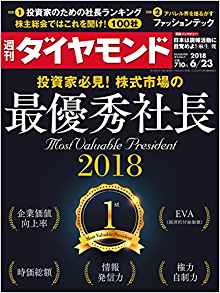
Buy this at Amazon / Buy this at Fujisan
No3: Weekly TOYO KEIZAI (週刊東洋経済 : 90,250 copies)
First published in 1895. Feature articles on seasonal themes and of various companies, there are many useful information for all generation including a student in job hunting. You can grasp the latest topic of the Japanese economy.
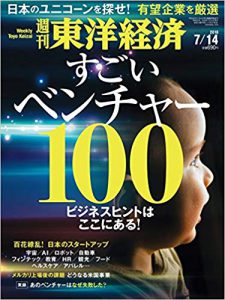
Buy this at Amazon / Buy this at Fujisan
No4: THE21 (49,400 copies)
First published in 1984. Monthly magazine. Many information is useful for self-improvement.

Buy this at Amazon / Buy this at Fujisan
No5: DIAMOND Harvard Business Review (ハーバード・ビジネス・レビュー : 20,700 copies)
The only comprehensive management magazine in Japan that fully cooperated with Harvard Business Review magazine in the United States. For managers and business leaders.
Sharp suggestions and explanations coming from opinion leaders are popular. It has plenty of information on strategy and analysis.
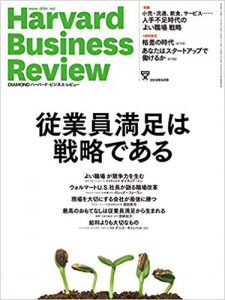
Buy this at Amazon / Buy this at Fujisan
Since all of these are dealing with a wide range of information, you can choose from your interests and positions of work.
Although it did not enter the top 5 in the number of sales, there are also many magazines that I would like to recommend. The following are some of them.
NIKKEI TRENDY (日経トレンディ)
Trendy information magazine introducing the latest trends and latest products. There are many easy-to-read contents.

Buy this at Amazon / Buy this at Fujisan
Monthly JIGYO KOUSOU (月刊事業構想)
Professional journal on corporate activity, regional creation, innovation. Monthly magazine. For managers / new business planning staff.
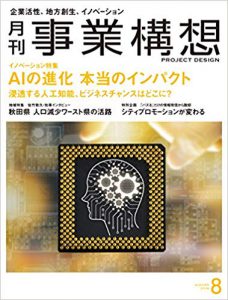
Buy this at Amazon / Buy this at Fujisan
SENDEN KAIGI (宣伝会議)
Specialized magazine of advertisement, advertisement, and marketing. Published twice a month.

Buy this at Amazon / Buy this at Fujisan
INTERNET SALES (ネット販売)
As its name suggests, it is a specialty magazine for online sales. Monthly magazine. Since it is not sold at a bookstore, go to the following link for purchase.

MARR(マール)
The only M & A special monthly magazine in Japan. For people involved in M & A.
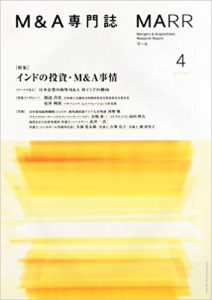
Buy this at Amazon / Buy this at Fujisan
I added links to Amazon and to Fujisan, but please note that images and links are not limited to the latest issue. At Amazon, it is easier to order one book, but at Fujisan, they offer discounts of up to 50% when subscribing. They delivers it to your home (limited to Japan only) and e-book version can also be read.
If you want to know other magazines, please consult your J-OS instructor or support team (^^)/
*1: As of July 9, 2018
*2: Source:Japan Magazine Publishers Association
Sharing economy in Japan
June 14, 2018
It became a hot topic that Airbnb canceled all reservations for properties that violate Japanese law. And it is said that there are still various problems in the sharing economy. However, as the Mercari listed soon, the sharing economy itself is growing also in Japan, so I would like to introduce Japan’s major sharing economy service this time.
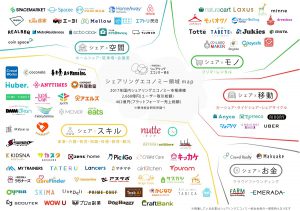
Sharing economies are generally classified into three categories: object shares, space shares, and skill share. (There are various opinions on how to classify.) The representative services of each are as follows.
(1) object shares
Mercari: The most famous in Japan as a flea market apps.
Laxus: All-you-can-use brand bags at 6,800 yen per month. Popular with young women.
Air Closet:A service that can wear three clothes chosen by a professional stylist at 6,800 yen per month.
Anyca :A service that allows you to lend and borrow a car among individuals.
If you like Initial D(Japanese manga), would not you want to drive this car?
This car that became famous by the movie “Wild Speed” should be popular.
※To use Anyca you need a driver’s license issued in Japan. International licenses are not acceptable.
(2) space shares
Space Market: Services to lend and borrow party venues, conference rooms, photography studios, etc.
Akkipa:Services to lend and borrow parking lots.
ecbo cloak:A service that introduces space that temporarily keeps luggage such as large suitcase which does not enter coin locker. The site also supports English, Chinese, Korean.
DogHuggy:A service that allows you to leave your dog at other dog-lovers. Many people use it instead of pet hotel.
(3) skill share
Basically it is a service that provides individual skills and free time, but some also provide housekeeping or manual labor. The following services are famous.
TimeTicket、Any+Times、Coconala、Street academy
There is also a service called Traveloco specializing in matching with Japanese guides living abroad.
Foreigners may seem surprising, but general Japanese people are cautious about “lending and borrowing for a fee”. (There are many people who will be kind to those in need.) There are many people who are concerned about trouble due to interaction between individuals in sharing economy. Therefore, many people think “Even if it is expensive, I will depend on the pros”.
Many of (1) are comparable to the services provided by professionals and are inexpensive, so the number of users is increasing even around me, but those who use the service introduced in (3) There is not much yet. For the service introduced in (2), users and usage frequency are limited, but there may be strong demand for specific users, specific timing.
It may be the nationality of the country to decide which sharing economy will be popular there, rather than the regulation problem.
10 Tips for Entertaining Business Clients
May 31, 2018
Following the previous blog “10 Tips for Entertaining Business Clients Preparation”, this time we will introduce five tips of the day of business entertainment and following up.

【On the day of business entertainment】
Show respect to key persons
Ask the director of Company A for the toast and ask the director of Company B for the closing remarks.(It is better to check in advance whether they can accept these greetings. )
Stay sharp even if you drink
Entertainment is a part of business. Even if client says “Le’ts loosen up and enjoy!”,you must behave responsibly.If you are in a position to invite, please always look after clients carefully if they are enjoying it.
Smart payment
Check the way of payment with your boss in advance whether your company will pay all or a split bill.If you need to pay, payment will be made before your client notice.
Ask your client for second party
If you invite your client for business entertainment, just in case, prepare the second party in advance.The location of the second party will be close to the venue of the first party.
【Following up】
Express your thanks to client within the next morning.
Tell your client? a feeling of thankfulness as quickly as possible (The best time is the next morning ).The most polite way is a letter, however, recently telephone is mainstream.

In Japan, “business entertainment” is done to get to know each other. Business entertainment has been stopped as frequently as before so as not to adhere to the outside of the company, but there is still a drinking party like a social gathering. Therefore, I will introduce 10 points of business entertainment so as not to fail in the entertainment scene.

[Preparation]
Do not judge by yourself if you are invited.
Some companies prohibit to invite or to be invited to the business entertainment. Make sure consulting with your boss before you reply. And, if you go, decide who will go as well.
Tell your clients who you will go with (especially your boss) in advance.
Let your clients know like “I will go by three members of ○○ of the department manager, □□ of section chief, and myself” in advance.
Generally we will ensure that the titles of both participants are balanced.
(In the position of inviting) Be careful not to forget to invite a key person.
When inviting to entertainment, there must be a purpose for it. And, roughly the purpose of business entertainment should be strengthening relationship with a key person. If you can not directly invite the person you want to meet, ask the other person of the company whether the key person can join the entertainment.
(In the position of inviting) Make sure what is Not Good
Make sure to ask clients about their allergies or NG foods.
(In the position of inviting) Choose a suitable restaurant
For business entertainment, you choose a restaurant with a private dining room to have conversations comfortably. There may be a noisy atmosphere in a cheap chain type Izakaya. If you do not know a good restaurant, ask your seniors and bosses for recommendations.
If you are working in Japan, you will often go to karaoke in a second party etc.
If you sing at karaoke and you can enjoy it with the Japanese, you can enjoy deepening relationship with your business partners.
The difficult thing for foreigners will be choosing a song that will be appreciated by Japanese people.
So, I will teach you the site introducing the ranking of Japanese songs by age.
1950’s Ranking: http://nendai-ryuukou.com/1950/song.html
1960’s Ranking: http://nendai-ryuukou.com/1960/song.html
1970’s Ranking: http://nendai-ryuukou.com/1970/song.html
1980’s Ranking: http://nendai-ryuukou.com/1980/song.html
1990’s Ranking: http://nendai-ryuukou.com/1990/song.html
2000’s Ranking: http://nendai-ryuukou.com/2000/song.html
* You can jump to the ranking of TOP 50 for each year from the link above.
* If you click on each song title, you will be connected to YouTube so you can listen to that song.
The point is “Choose songs that were popular when people going along were around 18 to 22”.
Because people listen to music the most during these ages.
For example, in my case, I often listened music from 1996 to 2000, so I checked the yearly ranking of 1996 to 2000. As a result, I found that each TOP 50 songs by year were very familiar.
If a person going to karaoke with you is around 50 years old, that person may often listens to songs of 1984 to 1988, so it is better to check these pages.
http://nendai-ryuukou.com/1980/song/1984.html
http://nendai-ryuukou.com/1980/song/1985.html
http://nendai-ryuukou.com/1980/song/1986.html
http://nendai-ryuukou.com/1980/song/1987.html
http://nendai-ryuukou.com/1980/song/1988.html
If you know old Japanese songs, it will be a good conversational material. Also, learning the song lyrics is useful for Japanese study.

Exciting Japanese company: Start Today
May 15, 2018
Do you know a site called ZOZOTOWN or a company called Start Today that runs the site?

ZOZOTOWN is Japan’s largest fashion mail-order site where many popular brands gather, and it has enormous popularity from fashionable people and young generation.
Start Today’s market capitalization exceeds 1 trillion yen, which is slightly higher than the goods plan managing MUJI, and more than twice the largest department store, Mitsukoshi Isetan HD. (As of May 9, 2018)
This time, I picked up this company for the following three reasons.
Reason 1: Business model is cool
Normally EC is prone to price competition and profitability tends to be low.
However, the company’s current profit margin for the most recent three years exceeds 30%, 32.86%> 34.61%> 33.26%.
This is because the company’s main business is consignment sales, sales are not sales value of apparel products, but from commission from shops.
The consignment sales commission rate is said to be around 28%, which is higher than department store with real store, and inventory risk is also not included because ownership of inventory is in shop.
Although the apparel brand may have its own EC site, since only brand products are sold, users wanting to buy products of various brands will buy with ZOZOTOWN.
In addition, the company attracted attention by issuing new products called ZOZO suit.
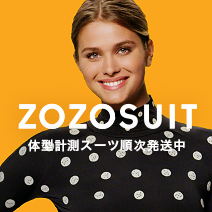

This is a suit for accurately measuring the shape of the user, allowing users to order at their exact size and ZOZO gains the strongest tool for selling their own brand products It will be.
Reason 2: Management is cool
Mr. Maezawa, president, is also a luxury car collector such as Bugatti Veyron, Aston Martin, Ferrari Enzo etc.
When he caused an accident while driving Pagani Sonda, the other car was Maybach, so it became a hot topic to have caused accidents between super luxury cars.
He is also famous as a collector of arts and paintings and it became a hot topic that he bought a painting of Bathkia’s for 12.3 billion yen at an auction. (Before that, he also paid 6.24 billion yen at auction for an art work of Buskia.) There are not so many Japanese executives of listed companies that spend money in this way.
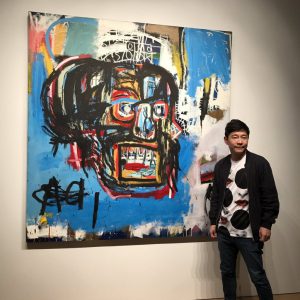
Reason 3: Personnel strategy is interesting
Working hours in Japan are generally from 9 to 5 o’clock, but ZOZOTOWN is 6 hours from 9 to 3 o’clock. Mr. Maesawa set a goal that “employees should give the best performance in the shortest time and use the remaining hours for fun.” Also, hiring highly qualified engineer at a maximum annual income of 100 million yen became a hot topic.
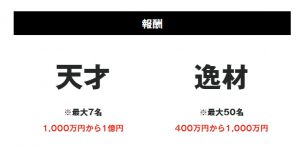
Since the company announced that it will strengthen overseas expansion by IR, the name of the company may be recognized in your country from now on.
PS
For Japanese learners who are interested in presentations, IR, economic terms, etc., I think that it will be a good learning to see IR movies.
How 18 Japanese companies got their quirky names?
May 10, 2018
Since I gathered most of the information from the Internet, there are some information that I do not know whether it is true or not.
But, especially for those with dealings with companies on this list, I think that it will be a good story.
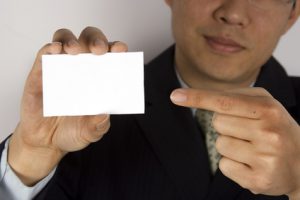
SONY (Sony)
It is combined the Latin “SONUS” which became the origin of English “SONIC” meaning sound, and English “SONNY” meaning boy.
Canon
“Cannon” was the first camera prototype machine with the thought of creating the best camera in the world with the help of Kannon(Avalokiteshvara).
It became English “Canon” because the pronunciation is similar and meaning of “standard”, “normality” are appropriate.
MINOLTA (Minolta)
Kana notation of “a ripening rice plant”.
※ Now merged with Konica and KONICA MINOLTA
NEC
Nippon Electric Company, Limited “that is written in English (Nippon Electric Company, Limited).
Sega (Sega)
From SERVICE GAME.
Bridgestone (Bridgestone)
Founder’s surname “Ishibashi” in English, “Stone Bridge”, turning it over to “Bridge Stone”.
EDWIN (Edwin)
“D” and “E” of “DENIM” are reversed, turning “NIM” 180 degrees to convert it to “WIN” and convert it to richness of idea and to EDWIN.
It is enthusiastic to want to do free thought utilizing denim.
As another theory, there are many Japanese jeans makers in Okayama prefecture, there is also the theory that the company that is the Tokyo headquarters to compete with it, “Edo wins” = “Edo + WIN” originated.
Glico (Glyco)
From “glycogen” discovered from oyster broth.
Calbee (Calbee)
Composite word of calcium + vitamin B series.
MOS FOOD SERVICES (Moss food service)
Mos Burger’s MOS is an acronym for Mountain, Ocean, Sun respectively.
“Mountain, the sea, the sun” mean “with noble and dignified like a mountain”, “with a deep wide mind like the sea” and “with a passion that does not burn out like the sun”.
fumakilla (Fumakira)
FLY + MOSQUITO + KILLER
Kao (Kao)
Face wash soap was initially called “face soap”. Face → Kao
DHC
The initials of Daigaku Honnyaku Center (University Translation Center).
Originally it was a company started from the translation industry and still uses its company name.
Chifure (Chihure cosmetics)
It is from the initials of the “National Regional Women’s Organization Liaison Council (Municipal Welfare Council.
AUTOBACS (AUTOBACS)
It adds Service to products (Appeal, Unique, Tire, Oil, Battery, Accessory, Car audio) to be provided.
From the philosophy that AUTOBACS SEVEN’s official name SEVEN always keeps searching for the seventh product for customers.
Secom (Secom)
It is a coined word that abbreviates the word “Security Communication”.
MARUHA (Maruha)
It puts the wave round and puts in the meaning that it wishes for safe fishing. It is a source full of kindness that prayed for fisherman’s safety.
STUDIO GHIBLI (Studio Ghibli)
GHIBLI (ghibli) means “hot air blowing in the Sahara desert”.
Hot feelings such as “Make a whirlwind in Japanese animation world!” are put in it.
How was it?
I was most surprised at the origin of DHC.
How many chat topics do you have?
April 26, 2018
How many chat topics do you have?
“Chat” is an easy talk without deciding the theme. As well as talking with family and friends, chatting is essential in dates and business.

When I ask the Japanese businessmen around me, they say that the chat is very important.
One of them insists that “If you do various interesting talks and impress the other person with your charm, business negotiations will proceed. If you talk about the product from the beginning, no one will succeed.”
I agree that it is more necessary to sell yourself than goods.
People who don’t run out of things to talk about are called “people with many drawers.”
Let’s hold a number of drawers in your head.
Here are four examples of chatting.
1, Weather talk
Japanese love to talk about the weather. It is likely to start from this topic in many cases. You do not have to talk from yourself. Please try to enrich the story of the weather that the other person speaks. Please keep in mind that you always return it positive way.
Example
A-san: “It is cold today, is not it?”
B-san: “Yes, it is said that it is the coldest winter this winter, but the cold weather makes hot sake delicious, so why do not we go drinking together next time?
2, News stories
From now on, let’s check the Japanese news. Besides big news, an interesting news such as “baby panda in Ueno” are also useful. If the other person likes animals or cute things, you may be able to mix those topics in the middle of the story. Also, Ueno is famous as a sightseeing spot, so you can use it when that story comes up. Television, internet and radio are useful, and referring advertisements in the train is also helpful to know outline of news. If you have news you care about, look it up on the spot with a smartphone.
3, Review your country
How well do you know about your country? Let’s check not only cultures and customs, but also current trends in your country. By knowing how it is different from Japan, you may be interested in the other party. You may also find the same place as Japan. A special products of your city is a good topic to talk about.
4, School days experiences
Have you tried hard on something? Not only your major field of study, but also part time job or your boom at that time can be a good topic for chat. It would be better to summarize some of the hardships into episodes rather than having fun. Japanese people are interested in how you have studied Japanese. Let’s recall, for example, what was difficult and what kind of words you liked.
Some people think that, “Even if I have stories, I cannot speak well!” However, listening to chats properly is one of the most important things. Especially for the people from Chinese background, I recommend that it is better to nod more than you normally do when listening the conversation.
Categories
Recent Posts
- I cannot keep up with meetings conducted in Japanese. Are there any good ways to study?
- Are there any good writing materials for business Japanese? (Three keys to developing business Japanese writing skills.)
- Are there any free materials available for studying business Japanese reading?
- Should I read newspapers for reading practice in business Japanese?
- Are there any good business magazines to practice reading business Japanese?
Archives
- August 2022
- June 2022
- May 2022
- April 2022
- March 2022
- February 2022
- January 2022
- October 2021
- January 2021
- August 2020
- July 2020
- June 2020
- May 2020
- April 2020
- March 2020
- February 2020
- January 2020
- December 2019
- November 2019
- October 2019
- September 2019
- August 2019
- July 2019
- June 2019
- May 2019
- April 2019
- March 2019
- February 2019
- January 2019
- December 2018
- November 2018
- October 2018
- September 2018
- August 2018
- July 2018
- June 2018
- May 2018
- April 2018
- March 2018
- February 2018
- January 2018
- November 2017
- October 2017
- July 2017
